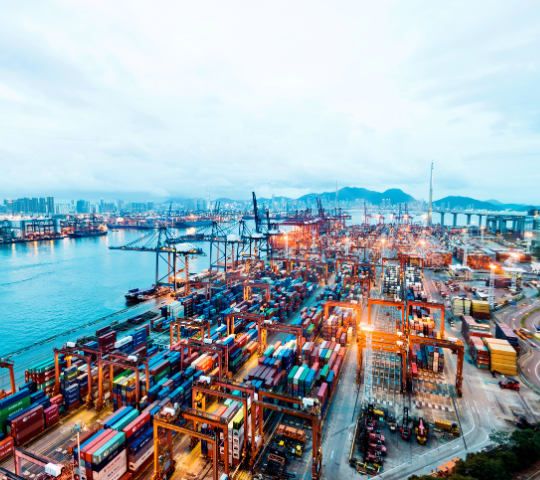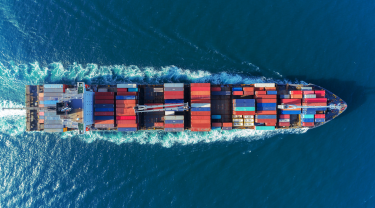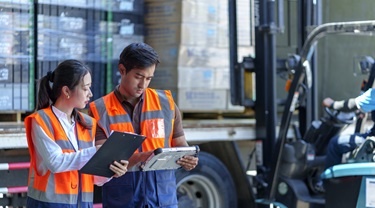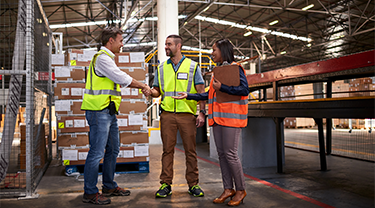In the current, unpredictable trade environment, tariffs remain top of mind for many companies.
Understandably, Canadian businesses want to stay up to date on trade risks in key markets, like the United States (U.S.), and learn more about tariffs.
Export Development Canada (EDC) is committed to helping Canadian exporters navigate trade challenges. Through the Trade Impact Program (TIP), EDC is facilitating up to $5 billion in additional support over two years for eligible exporters and suppliers. This support includes practical solutions such as:
- access to working capital
- credit insurance to protect against non-payment
- foreign exchange risk mitigation
- financing for global expansion
TIP is designed to help businesses manage tariff pressures, protect cash flow and stay competitive in global markets.
Since tariffs are a reality for companies engaged in international trade, understanding how they work can help you prepare your business for tariffs, shape your export strategy and manage risk while pursuing market diversification. Here’s a quick primer on tariffs to help you get started.
What is a tariff?
Tariffs are a type of tax that governments put on goods entering from another country. While general taxes, like sales tax or income tax, apply to transactions within a country, tariffs are used as a trade policy tool to influence the flow of trade and protect domestic industries. If you export goods outside Canada, your international customers may have to pay tariffs on the goods they buy from you.
How do tariffs work? Why do governments use them?
There are a few reasons governments choose to put tariffs on imported goods:
1. Tariffs generate revenue. Governments collect tariffs as they would income or sales tax. The money collected is put in the treasury and rolled into the state’s overall budget.
2. Tariffs can protect domestic industries. Officials may put a tariff on specific goods from outside the country if they feel a free flow of goods is hurting their regional or domestic producers. In this case, the government’s goal is to help domestic companies compete by making imported goods more expensive. The tariffs may also work as a deterrent for countries that are considering dumping surplus goods, which can undermine local pricing and put domestic companies out of business.
3. Tariffs may be deployed as a diplomatic tool. Governments sometimes limit or ban the import or export of goods and services from another country to influence behaviour in non-economic matters such as human rights, treaty violations, or war. A recent example is Canada’s economic sanctions on Russia for its destructive war against Ukraine. Rather than ban trade outright, governments may choose to impose high tariffs as an indirect trade sanction. The tariffs limit the offending country’s competitiveness by making their export goods prohibitively expensive, ultimately hurting its economy.
Who pays the tariff?
Tariffs are taxes levied on imported goods. While tariffs are collected by the government that imposes them, tariffs aren’t paid by one government to another.
The importer of record (IOR) pays the tariff to the customs agency when goods cross a border. The IOR can be the buyer, seller, or a designated agent such as a customs broker.
Responsibility for covering the tariff cost depends on the agreement between the buyer and seller. Often, the buyer pays the tariff, but the seller may agree to pay to simplify the cross-border transaction, or make their pricing more competitive.
No matter who pays the tariff, many companies pass the cost down to consumers by charging higher prices.
Ready to take the next step?
As Canada’s export credit agency, EDC is dedicated to helping businesses manage tariffs and grow globally. Use our quick tool to discover which EDC solutions are right for your business.
How do tariffs impact my business?
Tariffs imposed on Canadian goods make your products more expensive for buyers in the market where the tariffs are in force. Conversely, tariffs can also make the goods you import into your supply chain, or sell domestically, more expensive.
Here’s how tariffs can influence your price competitiveness:
1. Importers: Canadian-imposed tariffs can drive up the cost of making your product. For example, if you import aluminum wire for your jewelry business and this input is subject to a new 10% tariff, you’ll pay more for the material. To compensate, you’ll either have to charge more for the finished items or accept a lower profit.
2. Exporters: Tariffs are a trade barrier that make it harder to compete in international markets by raising prices for your goods or services. It’s important to know if the goods you’re shipping abroad will be subject to tariffs (also called duties) in the destination country. For example, tariffs between Canada and the United States have fluctuated over time, so it’s important to stay informed. If your goods are subject to a tariff and your competitors’ goods aren’t, you may find it challenging to succeed in that market. Customers may look elsewhere if your goods are more expensive because they’re subject to a tariff.
Are tariffs always bad for business?
While tariffs often increase costs and reduce competitiveness, they can also protect domestic industries by making imported goods more expensive. For some Canadian companies, tariffs on foreign competitors may create opportunities to grow market share at home. Tariffs can also encourage local sourcing, innovation, and investment in domestic production.
However, for exporters, tariffs are typically a barrier to growth. Understanding how tariffs affect your business is key to building a resilient export strategy.
How do I know if I’ll have to pay tariffs?
Canadian exporters can use the Canada Tariff Finder to get tariff information for specific products and countries where Canada has a free trade agreement (FTA).
The Government of Canada has additional online tariff tools for exporters to search for tariffs by product and country.
But not all trade is between two countries. The emergence of global supply chains over the past few decades means many products contain inputs from several countries. Goods may cross borders multiple times before they reach the final buyer. Knowing if you or your buyer will be subject to tariffs can be complicated if your business is part of such a supply chain. For this, you need to understand rules of origin.
How do rules of origin impact tariffs?
Origin is a product’s economic nationality, or where it’s from. Determining origin isn’t always easy. Does a product originate in the country where it’s manufactured? Or, is the originating country where materials were grown or sourced? What about modern products that are made of up components from all corners of the globe?
Rules of origin answer these questions. These international trade rules determine the source country of a product or service destined for export, which affects whether it’s subject to tariffs. Rules of origin are negotiated as part of every FTA. When no FTA’s in place, the World Trade Organization (WTO) rules apply.
All internationally traded goods must have their origin declared when they go through customs at the point of import. The Harmonized System (HS) classification facilitates this process and plays a central role in determining the origin of goods.
HS classification is an international customs system that assigns a unique six-digit HS code to each group of products, including food and raw materials, components of products and manufactured goods.
Knowing the HS code for goods you’re importing or exporting is the first step in determining if tariffs will apply. You also need to look at the specific rules of origin for your exports in your target market.
These online resources can help you get started:
- Canadian Export Classification: Look up the HS code for your goods.
- Rules of origin facilitator: Search for information on tariffs, trade agreements and rules of origin.
- Canadian Society of Customs Brokers (CSCB): Partner with a customs broker or find a freight forwarder to determine the correct code for your goods. It can be complex in some cases.
- Export Help Hub: EDC provides expert answers to the most frequently asked trade-related questions. Create a free MyEDC account to read more about rules of origin, or ask a question of your own.

What happens if you don’t comply with tariffs?
Not complying with tariff regulations can have serious consequences, including fines, shipment delays, seizure of goods and even legal action. Customs authorities could reject your shipment or impose penalties if your goods are misclassified, undervalued or lack proper documentation.
You can avoid those risks by working with a customs broker, understanding your product’s HS code and ensuring you meet all rules of origin and import/export requirements. EDC’s Export Help Hub can connect you with experts who can guide you through the process.
How can I avoid tariffs?
Canada has 15 FTAs in place that reduce or eliminate tariffs and provide Canadian companies with preferential access to markets around the world. These agreements also simplify the process of setting up operations abroad and provide better predictability, protection and transparency in foreign markets.
FTAs also reduce border-crossing delays, expedite product delivery and minimize regulatory red tape. Additionally, they foster commitments to broader goals, like environmental protection and human rights, while reducing risks associated with exporting such as potential litigation and classification issues.
Despite these benefits, FTAs don’t eliminate all tariffs on all goods. Even with preferential access to the market, your products or services may be subject to duties.
You should also check out
Expert guidance on how to manage trade regulations, customs requirements and international contracts.
How can trade diversification protect my business?
The only constant in international trade is change. It’s difficult to anticipate every economic and geopolitical shift that could lead to new tariffs in your export market. Relying on a single export market leaves your business vulnerable to disruptions that are outside your control.
Diversifying your exports by selling into several different markets at the same time helps you manage risk while opening the door to new opportunities. Canadian companies can leverage our growing list of FTAs to explore key markets for diversification, including the Indo-Pacific, Europe, Latin America and beyond. Even when conditions are stable, trade diversification is a smart play that can make your business more resilient.
Stay on top of change by exploring EDC’s quarterly Global Economic Outlook. It offers insights into economic shifts, sector risks and emerging opportunities for exporters.
Support for Canadian exporters
Trade Commissioner Service
The Trade Commissioner Service (TCS) helps Canadian businesses grow with confidence by connecting you with funding and support programs, international opportunities, and a network of trade commissioners in more than 160 cities worldwide.
Export Development Canada (EDC)
EDC is part of the Government of Canada’s trade ecosystem of experts available to help you save time, learn more about your target markets and identify the capital you need to grow.
EDC also offers:
- A full suite of credit insurance products to lower your risk for doing business abroad
- Help with getting access to working capital
- Expertise to enable you to learn more about international markets
- Connections to international companies in need of your products and services
- A Solutions Finder tool to help you identify which EDC products and services best fit your business needs
Interested in market diversification?

Explore your options by connecting with EDC.
Answer a few questions about your company and discover how EDC can help you plan, connect and grow in new markets.






